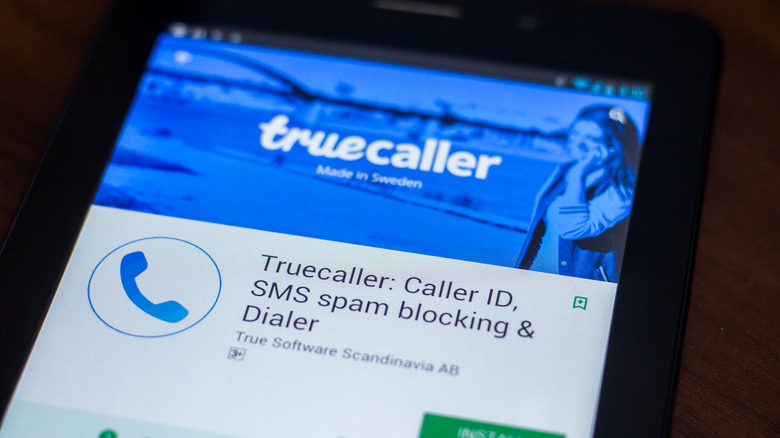Potential Spam Keeps Calling And Texting? What That Means (And What You Can Do About It)
It's been over two decades since 2003's introduction of the Federal Do Not Call Registry. At the time, it was supposed to be a game changer, allowing consumers to opt out of telemarketing phone calls, and for a while, it did what it was supposed to. However, if you check out the FCC's current web page for stopping unwanted calls, a caveat shows the one big weakness in the idea of the Do Not Call List as a catch-all: "Legitimate telemarketers consult the list to avoid calling both landline and wireless phone numbers on the list." (Emphasis ours.)
Scammers are scammers, so an extra layer of scamming isn't going to bother them. With technology making it trivial to have phones display false caller ID data, phone scams have become distressingly common. It's a problem without much of a systemic solution as of yet, to the point that the most common first line of defense is a carrier flagging the call as "potential spam" but not having any way to preemptively block it. As a result, managing spam calls is effectively a matter of harm reduction until a better, more global fix is available. So, let's look at the best ways to mitigate this problem.
What do you do if a spam call gets through?
Let's start with the situation alluded to in the headline: What do you do when confronted with a call that your carrier has flagged as possible spam? Not answering is a good first line of defense. A legitimate caller will leave a message and/or call back, after all. On the other hand, answering runs the risk of the scammer realizing that they called a working line owned by someone willing to pick up dodgy-looking calls.
If you do answer, it's best to hang up without saying or pressing anything. This goes for the aforementioned reasons but also because you don't want to give the scammers anything like, for example, a recording of you saying the word "yes" — much less personal information — that could be exploited by the bad actors. All told you need to do everything you can to keep the scammers from getting a leg up on you.
How can you spot non-flagged spam calls?
Spam filters aren't perfect, though, especially with how easily caller ID can be spoofed to show false information. Thankfully, scammers tend to have patterns that can help you identify possible malevolent calls so you can avoid answering them and enabling the scams. As always, the best move is probably just making a point not to answer calls from numbers you don't recognize and/or blocked numbers, but that's easier said than done. If you're expecting a call from your doctor, for example, they may be calling from a personal phone with a blocked number or a work extension that you don't recognize, so you're not going to ignore unfamiliar or unknown numbers in the meantime.
It's common for spoofed calls to be made to look like they're coming from your local area code, so that's a factor to consider. The bigger outright tell, though, is if the number shown on caller ID is distressingly close to your phone number. When that happens, you can be fairly sure that a spammer and/or scammer is awaiting you on the other end of the line. But if the number is simply local and unfamiliar? Circumstances dictate how likely it is to be a spam call. If you're not actively dealing with doctor's offices or otherwise in the habit of expecting calls from an unrecognized number, then an unfamiliar local number is a great reason to hesitate.
Again, if it's a legitimate call, they will reach you somehow. Only something time-sensitive like waiting on a personal call from your actual doctor or someone else you might not be able to call back directly throws a monkey wrench in that calculus.
Block unwanted calls with anti-spam apps
The best robocall-blocking solutions, though, come in the form of smartphone apps. All three major American mobile carriers have some kind of anti-robocall app for their customers: Verizon Call Filter, AT&T ActiveArmor, and T-Mobile Scam Shield. At their hearts, they all have the same basic functionality of identifying spam calls and sending them directly to voicemail, but there are some additional bells and whistles, as well.
Verizon Call Filter assigns a specific risk level to each call, allowing you to filter by how far along the risk continuum it is, and also gives you the option of what it calls the "neighborhood filter." This allows you to block numbers similar to yours and/or a specific area code and prefix/exchange combination. Meanwhile, for Scam Shield, T-Mobile claims to use "A.I., machine learning, and patented technologies" to block calls from bad actors, with its anti-spam database updated every six minutes.
For those looking for Android apps for blocking spam, Google's dialer, Phone by Google, has anti-spam protections — as does its Messages app — but there are also various dedicated anti-spam apps for both Android and iPhones. We have our own round-up of the best anti-spam call apps from 2017 that you can check out, but some of the most highly recommended options include TrueCaller, Hiya, and Mr. Number.
There are limited landline and VoIP options for reducing spam calls
Depending on your age and/or the kind of workplace you have, you may still be using copper landline phones or digital voice/VoIP lines day to day, and there is nothing like a smartphone for those. Thankfully, though the options are less limited in that space than they used to be, some anti-spam solutions are available for those using more traditional phone systems, with Verizon devoting a page on its website to spam prevention for its copper landline and Fios Digital Voice customers.
The most robust solution on paper is, perhaps unsurprisingly, for users of VoIP carriers like Fios Digital Voice. That comes in the form of Nomorobo, which claims to work with 127 VoIP carriers. (Cox, Verizon Fios, Spectrum Xfinity, Ooma, Optimum, Sonic, and Vonage are featured on the Nomorobo website, but there's a full listing on its carrier selection page.) Though the smartphone app version of Nomorobo for mobile users requires a paid subscription, the VoIP version is completely free. User reviews are mixed at best, with the TrustPilot average being just 1.5 stars out of five, but there aren't any better options, and it at least has Verizon's seal of approval.
As for traditional copper landlines, there are now phones with call-blocking features built into them and call-blocking boxes for those who don't want to get a new phone. These are generally limited to smallish pre-programmed known scammer databases and other limited blocking features, though. There's also imp, which is continuously updated but requires a $10 monthly subscription, a Wi-Fi connection to the internet, and a smartphone to use their app to manage the blocker device. It averages a 4.5-star rating out of five on TrustPilot.
What's the best option for the most vulnerable?
This all creates a bit of a conundrum: The most vulnerable users to spam/scam calls, the elderly, are the most likely to use landlines or cable company-provided VoIP lines for their voice service, the options with the least protections against robocalls. If you have an aging family member and you're genuinely worried about them falling victim to phone scams, then you're best off getting them a smartphone of some kind and setting up spam protections for them.
The Wirecutter has a guide to the best smartphones for seniors, reviewing options across all price points while including everything from current feature-packed flagships down to the Jitterbug-branded smartphones that include a custom-built senior-friendly Android user interface out of the box. Spam blocking was cited as one of the most important features by the reviewers, and if you're extra concerned, they even highlighted the RAZ Memory Cell Phone, which is specifically designed for older adults with memory and/or mobility issues.
So, if you're set on limiting an aging family member's exposure to scammers, finding the right smartphone for them, customizing the interface if needed, and equipping it with anti-spam measures is probably the best way to go.





